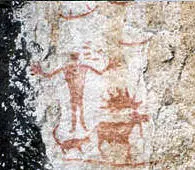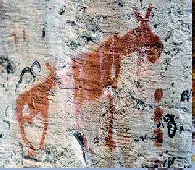 Scattered across the Boundary Waters and Quetico, left by its native people on canvases of stone, are hundreds of enigmatic paintings. These ancient Native American paintings, or pictographs, can be seen on cliffs bordering a number of lakes and rivers. These sites may be several hundred years old, although the age, the artists, and the purpose of the pictographs are yet unknown.
Scattered across the Boundary Waters and Quetico, left by its native people on canvases of stone, are hundreds of enigmatic paintings. These ancient Native American paintings, or pictographs, can be seen on cliffs bordering a number of lakes and rivers. These sites may be several hundred years old, although the age, the artists, and the purpose of the pictographs are yet unknown.
South Hegman Lake has one of the finest examples of original Native American Pictographs to be found, on a granite cliff overlooking the water. The panel shows a human figure in an outstretched arms posture standing near a quadruped animal with a long tail, possibly a dog or wolf, and a remarkably well drawn bull moose with splayed hooves and dew claws. (A dew claw on a moose is a reduced hind toe or the false rudimentary hoof above the true hoof .) Beneath these figures is a long horizontal line, probably representing the ground or horizon, and above the human figure are two vertical rows of short horizontal lines or dashes. One set has 4 lines and next to it are 3 lines. Above and to the right are what look like three canoes. The top two canoes have two paddlers and the third has a faint single one in the middle. Above the moose's rack is a single mark. Above all of these figures is a large cross like a "plus" sign, possible a a maymayguayshi spirit-man. Several feet to the left of the scene are other, faint pictographs including 6 horizontal lines, one above the other, three crosses above each other, and a "Y" shaped figure with a "C" shape to it with diagonal strokes. There may also be a spiral and grid-like figure near the water.
Carl Gawboy, an Anishinaabe artist from the Bois Forte Reservation and who taught for twelve years at the College of St. Scholastica and another six years at the University of Minnesota, Duluth, teaching American Indian Studies and watercolor painting, and whose father was a Nett Lake Ojibwe, first proposed that the meaning of the panel was linked to a series of Ojibwe constellations in the sky. In an April 6, 1992 newspaper article in the Duluth News-Tribune entitled "Ely Pictographs Linked to the Heavens" Gawboy suggested that the man with the outstretched arms is the Ojibwe version of a constellation in the area that we think of today as the constellation Orion. This figure is the Winter-maker and Gawboy suggested that the position of the pictographs on the cliff is oriented towards viewing the constellations in the winter sky (read more on Ojibwe (Anishinaabe) star knowledge and Carl Gawboy's proposal).
Michael Furtman in his book "Magic on the Rocks" compares the moose on Hegman to the paintings on Darky Lake in Quetico and suggests that they might have been painted by the same artist. The author also sees the panel as relating to the Ojibway story-legend of Nanabush, the four legged animal representing a wolf which is hunting the moose.
 There are at least 30 pictograph sites in the Superior-Quetico region. Large displays span the granite cliffs at Lac La Croix, Crooked Lake, and along the Kawishiwi River while smaller clusters of figures gather on Rocky and McAree Lakes. The majority of pictographs sites have at least two thing in common. Almost all drawings are red (a sacred color characteristic of aboriginal rock painting worldwide), and they are always near water, usually 2 - 5 feet above water level, suggesting they were painted by someone standing in a canoe. The red ochre paint was created by mixing iron hematite with boiled sturgeon spine or bear grease to depict their stories on the stone canvas.
There are at least 30 pictograph sites in the Superior-Quetico region. Large displays span the granite cliffs at Lac La Croix, Crooked Lake, and along the Kawishiwi River while smaller clusters of figures gather on Rocky and McAree Lakes. The majority of pictographs sites have at least two thing in common. Almost all drawings are red (a sacred color characteristic of aboriginal rock painting worldwide), and they are always near water, usually 2 - 5 feet above water level, suggesting they were painted by someone standing in a canoe. The red ochre paint was created by mixing iron hematite with boiled sturgeon spine or bear grease to depict their stories on the stone canvas.
Please remember that these rock paintings are very fragile, and can be easily damaged or destroyed. Do not attempt to touch the pictographs, and take only photographs.
